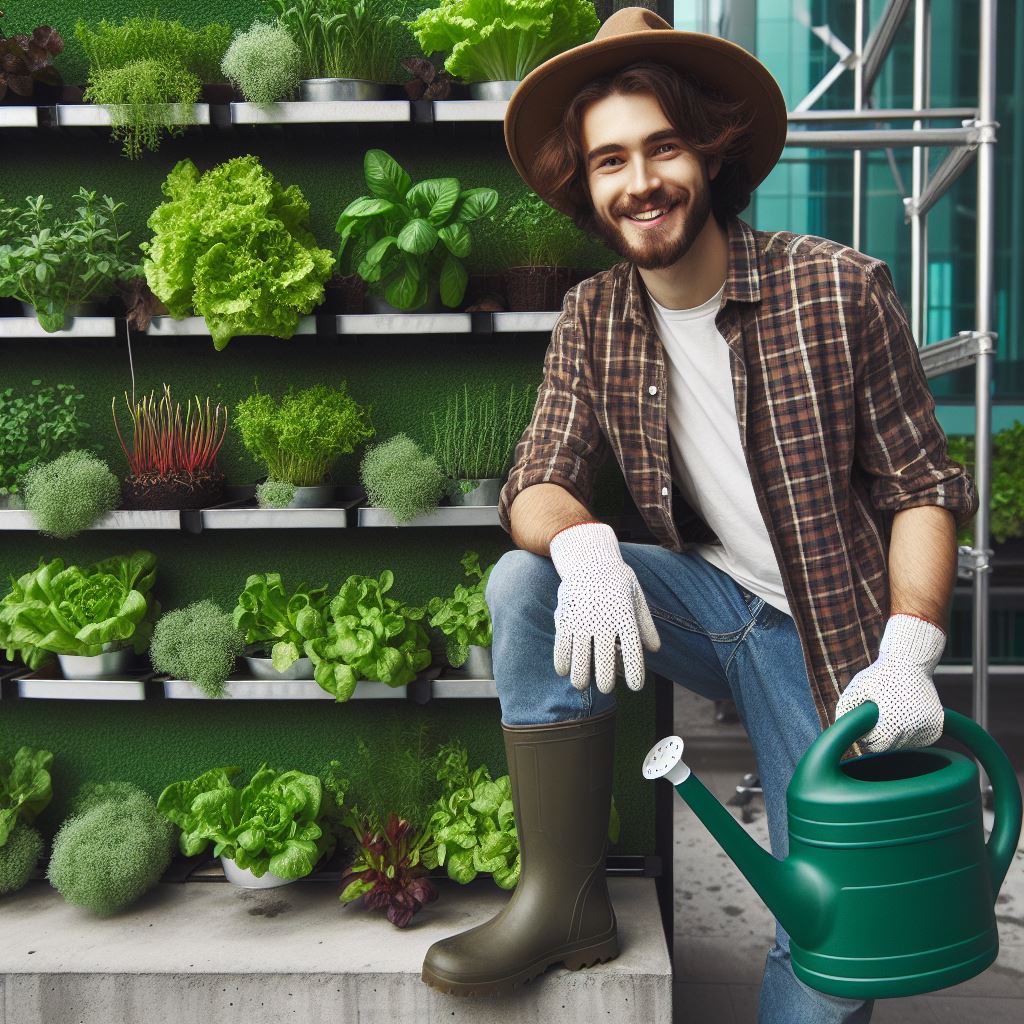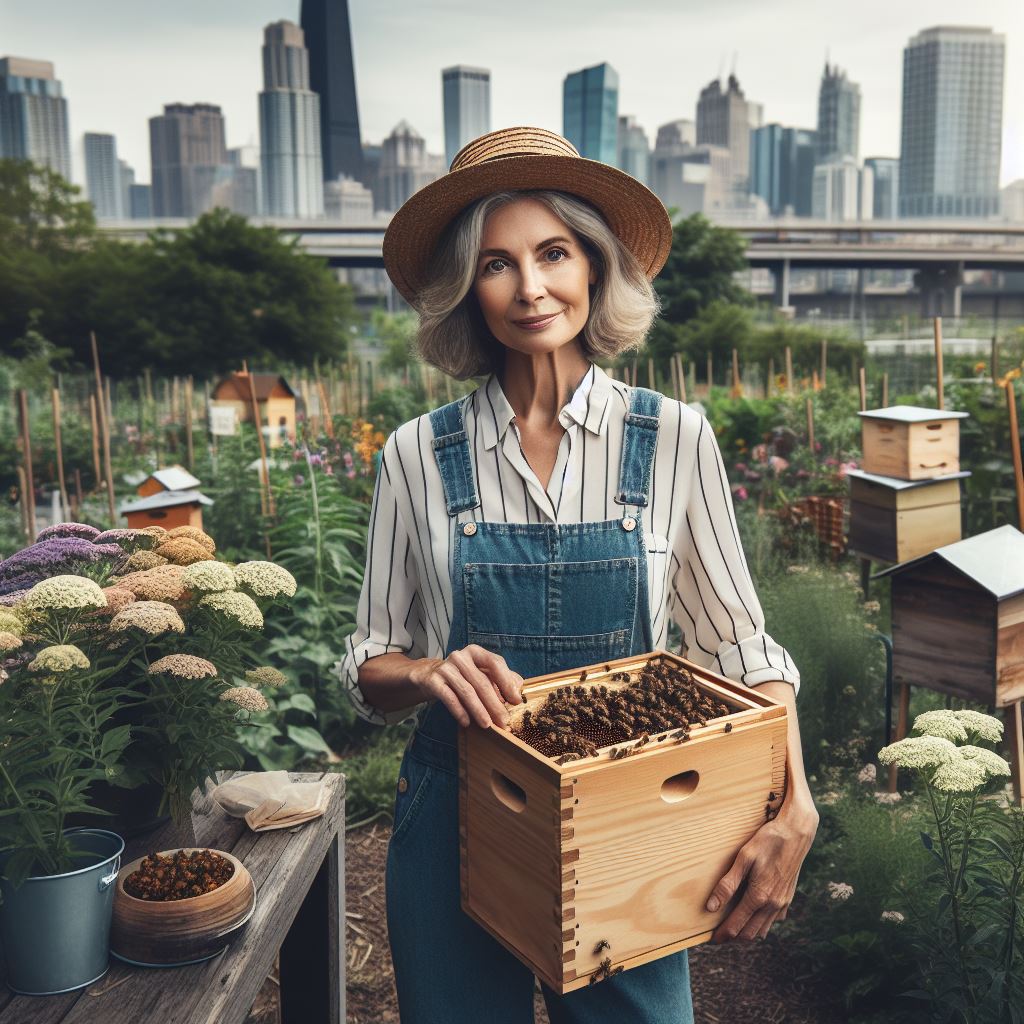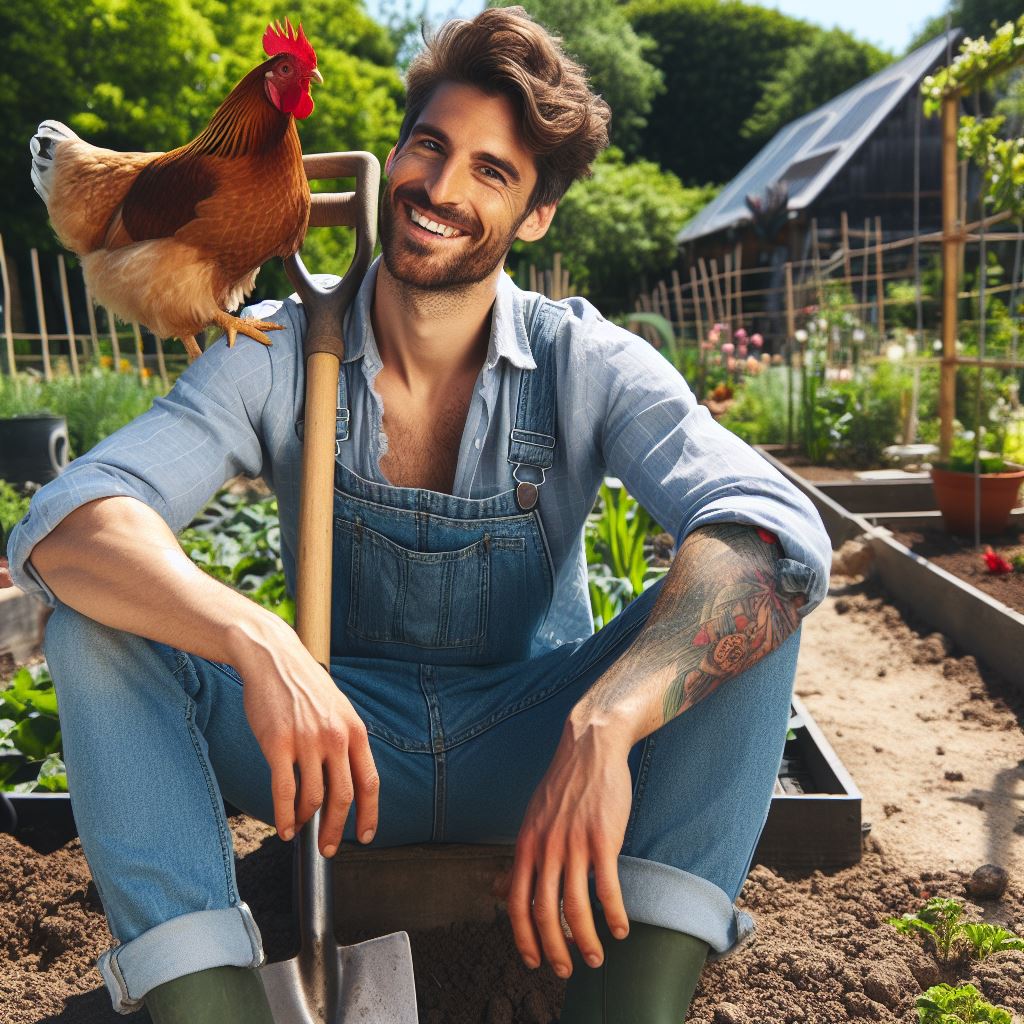Introduction
Indoor farming is a method of growing plants and crops in controlled environments, such as greenhouses or vertical farms.
In this section, we will explore the various techniques and benefits associated with indoor farming.
Indoor farming offers many advantages, such as year-round production and protection against pests and adverse weather conditions.
Additionally, it allows for efficient use of resources, including water and energy.
One popular technique in indoor farming is hydroponics, where plants are grown in a nutrient-rich water solution, without soil.
This method maximizes water efficiency and reduces the risk of soil-borne diseases.
Another technique is aeroponics, which involves growing plants in an air or mist environment, with nutrients delivered directly to their roots.
This technique is known for its high productivity and minimal water usage.
Vertical farming is also gaining popularity, especially in urban areas with limited land availability.
This method involves stacking multiple layers of plants vertically, using artificial lighting and controlled climate conditions.
Benefits of indoor farming include higher crop yields, as plants can be grown in optimal conditions with fewer environmental constraints.
It also reduces the need for pesticides and herbicides, resulting in safer and more sustainable food production.
Indoor farming has the potential to revolutionize the agricultural industry, providing a solution to increasing food demands and minimizing environmental impact.
By adopting these innovative techniques, we can create a more efficient and sustainable future for farming.
Read: Small Space, Big Yield: Urban Farming Tips
Transform Your Agribusiness
Unlock your farm's potential with expert advice tailored to your needs. Get actionable steps that drive real results.
Get StartedTechniques of Indoor Farming
Indoor farming has revolutionized agriculture, enabling efficient cultivation without relying on traditional soil-based methods.
By utilizing innovative techniques like hydroponics, aeroponics, aquaponics, and vertical farming, crops can be grown in controlled indoor environments to maximize yield and optimize resource usage.
Hydroponics
Hydroponics, a popular indoor farming technique, involves growing plants in nutrient-rich water without soil.
This method allows plants to access nutrients more efficiently, resulting in faster growth and higher yields.
Additionally, hydroponics eliminates the need for excessive water usage, making it an environmentally friendly option.
However, it requires precise monitoring of nutrient levels and pH to avoid nutrient deficiencies or toxicities.
The initial setup cost can also be high due to the need for specialized equipment.
Aeroponics
Another innovative technique, aeroponics, takes indoor farming to new heights.
It involves growing plants in an air or mist environment, with nutrient-rich mist delivered directly to the plant roots.
This method promotes faster growth, increased yield, and efficient use of water and nutrients.
However, aeroponics demands a high level of precision in mist delivery and requires regular monitoring to prevent potential diseases.
Aquaponics
Aquaponics combines aquaculture and hydroponics, forging a sustainable symbiotic relationship between fish and plants.
Fish waste provides natural fertilization for the plants, while the plants filter and clean the water for the fish.
This integrated system reduces water usage and eliminates the need for synthetic fertilizers.
However, maintaining the delicate balance between fish and plant needs requires constant monitoring and adjustment.
Vertical Farming
Vertical farming offers a solution for optimizing space usage in urban environments.
By cultivating crops in vertically stacked layers, farmers can minimize land usage and increase production capacity.
Vertical farming also reduces transportation costs and the carbon footprint associated with long-distance food distribution.
However, it necessitates advanced infrastructure, including artificial lighting and climate control systems, leading to higher energy consumption.
In fact, indoor farming techniques such as hydroponics, aeroponics, aquaponics, and vertical farming provide efficient alternatives to conventional agriculture.
These methods offer numerous advantages, including faster growth, increased yield, reduced water usage, and environmentally sustainable production.
While each technique has its own set of advantages and disadvantages, they collectively contribute to the advancement of indoor farming as a solution to food security and environmental challenges.
Read: Urban Composting: Turning Waste to Gold
Benefits of Indoor Farming
Year-round cultivation
- Elimination of seasonal limitations
- Increased food production
Indoor farming offers several benefits that contribute to its growing popularity in the agriculture industry.
Showcase Your Farming Business
Publish your professional farming services profile on our blog for a one-time fee of $200 and reach a dedicated audience of farmers and agribusiness owners.
Publish Your ProfileOne of the most significant advantages is its ability to support year-round cultivation, free from the limitations imposed by changing seasons.
Unlike traditional outdoor farming, indoor farming techniques allow for continuous production regardless of the weather conditions.
The elimination of seasonal limitations brings about numerous advantages, the primary one being increased food production.
With indoor farming, crops can be grown and harvested throughout the year, resulting in a higher yield.
This continuous supply of fresh produce helps meet the growing demands of the population and ensures food security.
Conservation of resources
- Water efficiency
- Reduction in pesticide use
Another benefit of indoor farming is the conservation of resources.
By employing advanced irrigation systems, indoor farms can efficiently manage water consumption, significantly reducing the amount of water required compared to traditional farming methods.
Indoor farming also contributes to a decrease in pesticide usage. With the controlled environment provided by indoor farms, pests and diseases can be better managed without relying heavily on chemical pesticides.
This reduction in pesticide use benefits both human health and the environment.
Climate control
- Protection from extreme weather conditions
- Optimization of growth conditions
One of the major advantages of indoor farming is climate control. Indoor farms provide a protective shield against extreme weather conditions such as storms, droughts, and frost.
This protection ensures a stable and consistent environment for plant growth, minimizing the risks associated with unpredictable weather patterns.
Moreover, indoor farms allow for the optimization of growth conditions.
Farmers can tailor the temperature, humidity, and lighting to the specific needs of different crops, creating ideal conditions for them to thrive.
This control over growth parameters maximizes crop productivity and quality.
Reduction of transportation costs
- Local production and distribution
- Decreased carbon footprint
Indoor farming also contributes to reducing transportation costs and environmental impact.
By establishing indoor farms closer to urban areas, local production and distribution are facilitated.
This eliminates the need for long-distance transportation, reducing carbon emissions associated with transporting food from rural to urban regions.
Furthermore, indoor farming helps decrease the carbon footprint by minimizing the energy required for transportation and refrigeration.
The proximity of indoor farms to consumers enables the delivery of fresh produce without the need for excessive packaging or refrigeration, thereby reducing energy consumption and greenhouse gas emissions.
In general, indoor farming brings various benefits that make it a sustainable and efficient method of food production.
Its year-round cultivation eliminates seasonal limitations, increases food production, and ensures food security.
The conservation of resources through water efficiency and reduced pesticide use promotes environmental sustainability.
Climate control allows for optimized growth conditions and protection against extreme weather conditions.
Lastly, the reduction in transportation costs and carbon footprint make indoor farming a promising solution for local production and distribution.
Read: Sustainable Soil Management in Cities

Successful Examples of Indoor Farming
Case study 1: Gotham Greens
Overview of the company and their techniques
Gotham Greens is a pioneering urban agriculture company that grows pesticide-free greens and herbs.
They utilize advanced hydroponic systems, LED lighting, and climate control technology to optimize plant growth.
Success and impact on urban communities
Gotham Greens has established multiple rooftop greenhouses across cities like New York and Chicago.
Their locally grown produce has significantly reduced food miles and carbon emissions.
They provide fresh, nutritious, and sustainably grown food to urban communities, improving access to healthy options.
Case study 2: AeroFarms
Overview of the company and their techniques
AeroFarms is an indoor farming company using aeroponic technology to grow leafy greens without soil.
They create a nutrient-rich mist that is sprayed directly onto the plant roots.
Achievements and contributions to sustainable agriculture
AeroFarms has set up the world’s largest indoor vertical farm in New Jersey, producing tons of greens annually.
Their closed-loop system uses 95% less water than traditional farming and no pesticides, reducing environmental impact.
Their techniques show the potential for sustainable agriculture even in urban areas with limited space.
Case study 3: Indoor AgCon
Overview of the event and its significance
Indoor AgCon is an annual conference bringing together experts, innovators, and investors in indoor farming.
It serves as a platform to discuss the latest trends, technologies, and challenges in the industry.
Showcase of different indoor farming technologies and practices
Indoor AgCon exhibits a wide range of indoor farming technologies, including vertical farms, aquaponics, and AI-driven systems.
Participants share best practices, exchange ideas, and foster collaborations to further advance indoor farming globally.
These successful examples demonstrate the growth and potential of indoor farming in revolutionizing agriculture and addressing food security issues.
Showcase Your Farming Business
Publish your professional farming services profile on our blog for a one-time fee of $200 and reach a dedicated audience of farmers and agribusiness owners.
Publish Your ProfileAs urban populations continue to rise, the demand for fresh, locally sourced produce increases.
Indoor farming offers a sustainable solution by utilizing innovative techniques that maximize production while minimizing environmental impact.
Gotham Greens has shown how urban rooftops can be transformed into productive farms, providing communities with access to high-quality, fresh vegetables.
By using hydroponics and LED lighting, they have optimized their growing process, reducing the need for pesticides and saving energy.
AeroFarms has taken indoor farming to new heights with their aeroponic system, eliminating the need for soil and minimizing water usage.
Their groundbreaking technology has enabled large-scale production, opening doors for sustainable agriculture in urban areas.
The Indoor AgCon conference brings together key stakeholders in the industry, allowing them to exchange ideas and showcase the latest advancements.
This gathering of experts further promotes collaboration, which is crucial for pushing the boundaries of indoor farming and increasing its global adoption.
Overall, these successful examples highlight the benefits of indoor farming, such as reduced carbon emissions, minimized water usage, and increased access to fresh and nutritious food.
As the world continues to face challenges in traditional agriculture, indoor farming presents a promising solution for a more sustainable and food-secure future.
Read: Eco-Friendly Farming in City Settings
You Might Also Like: 8 Sustainable Farming Hacks You Need to Know Now
Conclusion
To recap, we have discussed various techniques and benefits of indoor farming.
Indoor farming, employing vertical stacking and hydroponics, maximizes space and water usage, fostering sustainability.
LEDs, tailored for plant growth, enhance photosynthesis, ensuring optimal yields. Year-round production mitigates seasonal limitations, ensuring a consistent and reliable food supply.
Reduced transportation distances decrease carbon footprints, contributing to environmental preservation.
Additionally, controlled environments minimize the need for pesticides, promoting healthier produce.
The future holds promise as technology advances, fostering greater efficiency and affordability in indoor farming.
Smart systems, integrated with artificial intelligence, will revolutionize crop monitoring and management.
Innovations like vertical farms in urban landscapes will redefine agriculture, adapting to growing global population demands.
Embrace the future of sustainable agriculture. Support research, investment, and implementation of indoor farming methods.
Let’s cultivate a greener, healthier tomorrow through widespread adoption and exploration
The future of indoor farming holds great potential for increasing food production and sustainability.
It is crucial for us to take action and further explore and adopt indoor farming methods for a more sustainable future.




